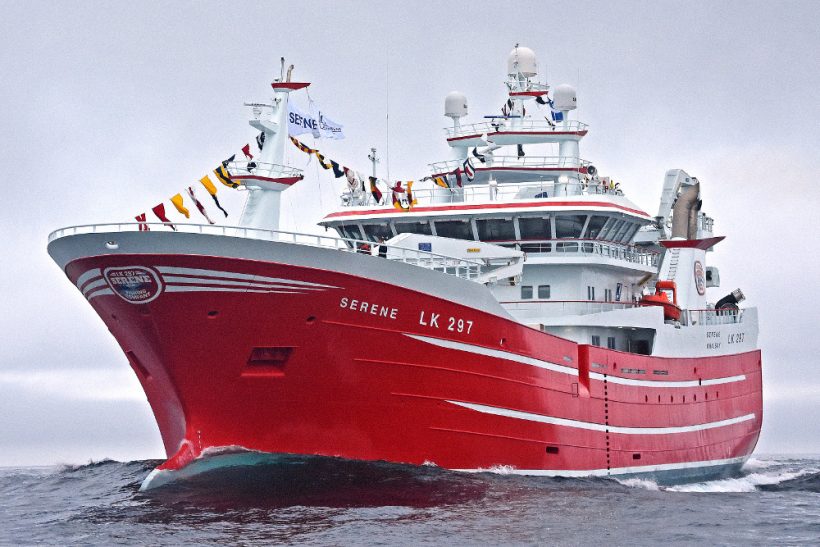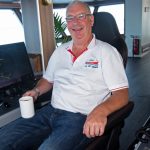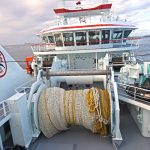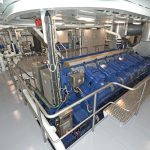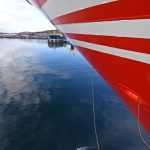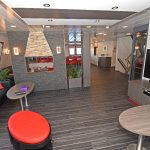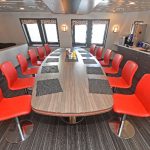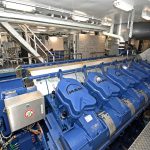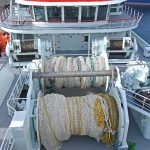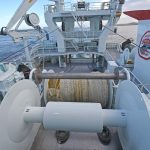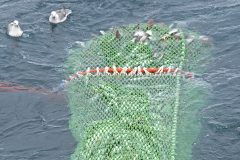Karstensens delivers first pelagic vessel to Shetland
Skipper Bobby Polson and the crew of the new Whalsay midwater trawler Serene LK 297 quickly started to prove the fishing credentials of their new boat by landing three back-to-back 930t, 950t and 1,500t shots of prime-quality MSC-accredited North Sea herring, within a week of the advanced vessel arriving in Shetland, reports David Linkie

Skipper Bobby Polson.
Of 82m LOA, Serene is reported to have performed well on three quick-fire shakedown trips in the first eight days after leaving Lerwick, to start fishing herring east of Start Point, Orkney, less than 100 miles from harbour. The third landing came from three short tows completed in just six hours of fishing time.
Skipper and crew expressed their full satisfaction with the efficiency of the vessel’s engineroom and deck machinery, fish pumping/storage systems, and electronics equipment, together with the well-matched fishing gear.
This smooth start highlights the forward thinking and vision of everyone who contributed towards the end result of a design and build project that the Serene Fishing Company initiated by contacting Karstensens Shipyard in spring 2015.

Midwater trawling activities are carried out aft on the full-length boat deck.
Serene Fishing Company is a Whalsay-based partnership comprising Bobby Polson and his longstanding partners Tommy Eunson, Leonard Polson, George Polson, David Shearer, Brian Sutherland, Gibby Williamson and Bobby Polson Jr.
As the first midwater vessel Karstensens has built for Shetland, Serene represents a significant achievement for the family-owned Skagen shipyard, and one that further consolidates its position as the prime designer and builder of larger pelagic fishing vessels.
As Serene made the short passage from Whalsay south to Lerwick, skipper Bobby Polson said: “Taking delivery of a new midwater trawler from Karstensens has been a long-held ambition of the Serene Fishing Company. The end result fully justifies our decision, as Serene far exceeds any expectations we might have had.

General view of the main wheelhouse consoles and the Furuno video wall.
“Completing three successful trips in little more than a week of leaving Lerwick underlines the reliability and quality that Karstensens is renowned for delivering, and deservedly so.
“From the initial contact, every single member of Karstensens team has been superb to work with. At every stage of the design and build programme, the level of professional co-operation and friendly support we have received has been exceptional. The layout of the boat, together with the quality of workmanship, more than speaks for itself. While the level of finish in the internal accommodation areas is self-evident, it is fully matched throughout the boat by the equally impressive pipework.
“Midwater trawling is not without its challenges, particularly when fishing mackerel to the west of Scotland in January and February, where sooner rather than later, Serene will be well-tested. If first impressions are any guide, she will take these in her stride and prove to be a safe and efficient boat in years to come.

Skipper Bobby Polson congratulates MD Knud Karstensen on a good job well done, watched by Torben Beierholm, Kent Damgaard and Nicolai Kristensen.
“The commitment the new boat means for Serene Fishing Company also illustrates the partners’ positive views on the long-term future of our industry. Pelagic stocks are extremely healthy. Together with consistently high levels of consumer demand around the world, this should be an extremely encouraging position.
“At the same time though, concern remains about the ever-widening discrepancy between actual stocks levels and scientific advice. We are seeing vast amounts of mackerel on the grounds, yet this is not supported by fisheries scientists, who are using two- to three-year-old data. Also, when carrying out stock assessment work, they are looking in the wrong places and at the wrong times. This situation needs to be addressed sooner rather than later.”
One of the underpinning principles in the design and fit-out of Serene is the marked reliance the owners placed on a layout that proved successful on their previous boat, on which the deck machinery was located at boat, rather than shelterdeck, level.

Overall view of the engineroom.
The decision to build a new boat was taken primarily because of the robust mackerel stock and high levels of demand for pelagic fish, where quality is all-important in a highly competitive global market. The owners, therefore, placed particular importance on optimising crew safety, fishing efficiency and catch quality, together with free-running and towing capabilities.
Agreement was quickly reached that these objectives would be best met by increasing the LOA and beam of the new Serene compared to her predecessor, thereby fully utilising the tonnage available to the owners.
Being designed solely for midwater trawling immediately simplified aft arrangements on the full-length boat deck, the use of which also freed up considerable internal room below this level.
Featuring three continuous decks – main, shelter and boat – Serene’s round bilge hull has a beam of 17.2m, a depth to first deck (boat) of 12.35m, and a scantling draft of 8.6m. After being built to DNV-GL +1 Fishing Vessel, Hull: Ice-C class at the Nauta Shipyard in Gdansk, Poland, the hull, complete with all superstructures, was towed to Skagen in February 2018 for machinery installation and fitting-out.
One of the standout features of the new Serene is the amount of internal space available throughout the vessel. This, in turn, leads to a second notable feature – the ease of access to main and ancillary machinery. Two examples of this are that the main hydraulic room is arranged across the full beam aft, and that the array of control valves and machinery for the RSW and related equipment is arranged over two levels amidships.
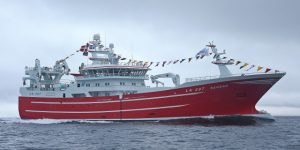
The 82m Serene steaming at 14 knots past Muckle Fladdicap, east of Whalsay.
At the same time as ensuring maximum levels of service accessibility for the future, Karstensens has also taken proactive measures to extend the longevity of all equipment, as the frequent presence of hi-spec dehumidifiers, in compartments where moisture and condensation are also inevitable, clearly illustrates.
The third, and most instantly apparent, standout feature is Serene’s streamlined profile, allied to the clean appearance of the forward decks. A stylishly raked foremast is set atop the forecastle, under which two anti-roll tanks and the mooring winches, served by hydraulically operated mooring platforms either side of the stem, are located.

The forward view from the port mooring platform.
Another interesting feature is the enclosed fish/seawater separator amidships, which is protected through 270º by a walk-in horseshoe-shaped deckhouse. Representing a significant first for Karstensens, this structure houses a fish-sampling room, as well as companionways leading down to the shelterdeck.
The presence of an integrated fishing system, displayed on a five-screen Furuno video wall comprising five 55in pedestal-mounted monitors, is a further interesting development in the wheelhouse, which itself is arranged in an innovative two-level design.
General arrangement
The long forecastle and wrap-round upper boat deck aft, positioned on top of the full-length boat deck, give a streamlined profile, further enhanced by the stylish wheelhouse, on which a double radar gantry is mounted.
With a capacity of 2,900m³, Serene’s 11 RSW tanks are arranged from forward in four tiers of three, two, two and four. The two middle tiers are positioned adjacent to the hull sides, to create a large central area in which the vessel’s RSW, refrigeration and vacuum landing plant is housed on two decks amidships.
Below the main (third) deck, the hull is subdivided into forepeak, bow thruster/sonar room, forward insulated RSW tanks, pump/manifold room, aft insulated RSW tanks, engineroom, and aftpeak with lube/hydraulic oil and freshwater tanks.
At main deck level, the arrangements from forward are forepeak, RSW trunk section, vacuum landing/refrigeration plant rooms, aft RSW trunking, engine control room/adjacent switchboard/converted room (starboard), engineer’s workshop (port), engine storeroom (central), and hydraulic room housing the Rolls-Royce Tenfjord steering gear.
Layout on the shelter (second) deck consists of forepeak, harbour genset room, storeroom with central room for vacuum compressors, and tank deck with loading pipes for RSW tanks. The main RSW control room is located to port in the accommodation casing, with a large window providing the engineer with a comprehensive forward view of activity at the tank tops.

Aerial view of Serene. (Photo: Ivan Reid)
Ten single en suite cabins, each of which features photographs of fishing activity on previous Serenes, are accessed from a wider-than-usual main corridor, which also leads to a laundry, multi-gym and steam room. A large net store, served by three hydraulically operated hatches on the trawl deck overhead, lies across two-thirds of the aft section to starboard of the crew’s protective clothing/storage room.
The boat (first) deck is arranged with forecastle housing anchor/mooring winches, hydraulically operated mooring platforms, and integrated roll damping tanks. The fish/seawater separator forward of the accommodation casing is surrounded on three sides by a central deck house, the forward section of which houses a fish-sampling room.

One of the 14 single-berth cabins on Serene.
The superbly finished lounge is located to port in the main deck house, forward of a cinema room. A single large mess table to starboard is positioned forward of the galley, in which cook Allen Park Anderson has a wide range of equipment at his disposal, including a double induction hob and deep-fat fryer flush-mounted in a central island unit, in addition to heated serving trays and a chilled cabinet adjacent to the mess table and drinks machines. A walk-in dry provisions store, together with separate fridge/freezer rooms, are accessible from the galley as well as off the boat deck.
A further four single-berth en suite cabins, together with an externally accessible hospital room, are arranged at upper boat deck level, directly below the wheelhouse.
Serene features an exceptionally high level of internal finish throughout the accommodation areas, which really has to be seen to be fully appreciated. Light grey planked flooring underpins an understated modern look, which is further enhanced by a selection of photographs spanning 40 years of the Serene Fishing Company, Whalsay and Skagen.
The extensive use of solid walnut, beautifully crafted and finished in-house by Karstensens, is a key feature of the internal finish.
Engineroom
Serene features a diesel/electric propulsion system, which is now becoming an increasingly standard feature on new pelagic vessels.

MAN 12V3244CR-TI main engine.
The Tier II-compliant MAN 12V32/44CR-TI (common rail/long stroke) propulsion unit drives a Scana Volda 4,500mm-diameter four-bladed CP propeller system housed in a high-performance fixed nozzle through a Scana Volda two-step gearbox. Respective Step 1 and Step 2 reduction ratios of 5.55:1 and 7.5:1 give propeller speeds of 135rpm and 100rpm, and main engine outputs of 7,200kW and 5,040kW.
This combination of centreline machinery enabled Serene to return an average top speed of 17.2 knots on sea trials.
A PTO on the gearbox drives an AEM shaft generator delivering 3,500kWe @ 1,200rpm.
Auxiliary electrical power on Serene is provided by two MAN 6L21/31 gensets. Generating 1,245kWe each, these are housed in a soundproofed compartment on the port side in the engineroom. A Cummins QSM11-DM harbour/emergency genset of 250kWe is located in the forepeak, while a smaller Cummins QSB7-DM genset of 125kWe is located in the auxiliary engineroom aft.
When Serene is hauling and shooting the midwater trawls, the gearbox PTO will be clutched in, enabling the shaft alternator to supply electrical power for the electro-hydraulic motors driving the winches and net drums. This arrangement reflects the fact that when full power is required for the deck machinery, there will normally not be the same demand for power on the main engine, allowing it to meet requirements for both the propulsion and hydraulic systems.

Rolls-Royce Tenfjord steering gear.
During normal towing, the shaft alternator can be disengaged from the switchboard, when electrical power is supplied by either of the gensets through the main switchboard and controlled by the vessel’s DEIF power management system. A bus-bar breaker is also fitted in the main switchboard, allowing the aft thruster to be fed off the shaft alternator, while the forward thruster and domestic load are supplied by the gensets.
The vessel’s electrical power system is fitted for sliding frequency (60-50Hz), by means of frequency converters for 400/440V and a rotating frequency converter for 230V. This arrangement allows the main engine and propeller rpm to be reduced by 17%.
A dedicated clutch fitted between the main engine and gearbox enables the shaft generator to function as an electric motor, being fed off the auxiliary engines. Up to 2,000kW can be used for this take-me-home diesel-electrical propulsion drive, which on engine trials gave Serene a highly creditable speed of 11 knots.
The main and auxiliary engines are served by GEA Bloksma freshwater box coolers.
Two Brunvoll electrically driven tunnel thrusters of 1,400kW, in which skewed bladed propellers combine optimal thrust with low noise, assist vessel handling in confined areas, and when keeping station to fishing gear.
The combination of double bottom and deep fuel tanks allow 547,000 litres of fuel to be carried. The vessel’s domestic freshwater capacity is 73,000 litres. Two 100m³ passive anti-roll tanks are positioned forward on the boat deck.
Engineers David and Jimmy Shearer monitor the performance of all the vessel’s propulsion and generating machinery, catch storage, and the comprehensive alarm systems from a separate soundproofed control room and office, when sharing 24-hour watch duties, during which functions throughout Serene are constantly monitored through the Marine Control Services vessel management system.
Karmøy AS deck machinery
Serene’s full package of bespoke midwater trawling machinery, together with the equipment for the associated electro/hydraulic drive systems, was supplied by Karmøy Winch AS, in Kopervik, Norway.
The two 90t core-pull split trawl winches are positioned either side of the centreline abaft the accommodation casing on the boat deck, and are operated through a Karmøy Winch autotrawl system.
Spooled with 2,000m lengths of 38mm-diameter Oliveira trawl wire, supplied direct to Serene from Portugal, the winches are angled slightly inwards to lead to inboard hanging blocks suspended within the underside of the stern gantry, to which companionways give ready access. This arrangement ensures that the crew have clear and immediate access to the midwater gear from two levels when clipping on/off helper pennants/backstrops, etc.
Integrated into the stern construction of Serene, the two-level trawl gantry also accommodates tail-end and top-line blocks (starboard), together with two knuckle boom deck cranes and the net-sounder winch.
Midwater trawls are worked from two 111t net drums positioned centrally in a low-profile waterfall formation above the boat deck. The net from the slightly higher forward drum is shot over a large-diameter stainless steel roller mounted above the lower net drum.
In addition to the SNG net (see page 10), Serene started fishing with a 1,100m dual-purpose herring/mackerel midwater trawl from Selstad AS, Måløy.
KT Nets of Killybegs supplied two 80m heavy-duty eight-panel herring/mackerel brailers, with 50mm meshes on the inner bag and 160mm meshes in the outer cover.
Serene is using a set of Thyborøn Type 15 VF 1,400kg trawl doors, incorporating adjustable flaps that enable the surface area to be altered to suit fishing conditions, and 100m sweeps, to spread the midwater trawls.
An 83t lifeline winch for handling the bag is located aft of the starboard trawl winch on the upper boat deck.
A 57t tailend winch, used for pulling the bag to the stern before the sock is taken up and attached to the aft fish pump, is positioned to port on the upper boat deck, in line with a dedicated purpose-built sheave mounted within the mid-height trawl gantry.
Three outhaul winches are mounted on the underside of the stern gantry, for use when shooting away the bag and other duties on the trawl deck. When fishing in heavy weather, the single opening through which midwater trawls are worked can be sealed off by raising a hydraulically operated vertical door, positioned aft of the customary four hydraulically operated guiding-on pins and the deck tracks for the toe-end weights.

The lifeline winch is mounted on the upper boat deck, aft of the starboard trawl winch.
Serene’s deck machinery is powered by 3 x 110kW, 8 x 87kW, 3 x 55kW and 2 x 30kW electro/hydraulic power packs, situated in the full-width pump room on the main deck aft.
Fish pumping
At the end of a successful tow, catches of herring and mackerel are taken aboard aft on the portside of Serene, before the fish are pumped forward to the dewatering system located on the boat deck amidships. The water separator was designed and built by Karstensens, as is normal with its new builds.
SeaQuest Systems of Killybegs supplied two of its well-proven 24in fish pumps.
Having been the first Shetland skipper to embrace stern pumping when the previous Serene was delivered in 2009, skipper Bobby Polson had no hesitation in opting for similar arrangements on the new boat.
While using the net drum to dry up the brailler, the 57t tail-end winch mounted to port on the upper boat deck is used to haul the bag back to the quarter, before the sock is attached to the pump located on the upper boat deck, just forward of the trawl gantry.
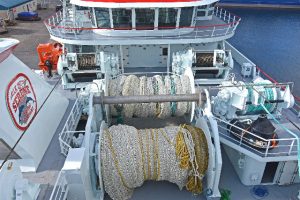
Two 111t net drums are positioned across the vessel’s centreline in a low waterfall arrangement.
After the 24in SeaQuest pump is lowered into the water by the dedicated overhead crane and the bag slackened off, 80m of 20in fish hose is spooled off the drum.
The large-diameter reels, on which the fish hose and hydraulic pipes are stored, are situated on the portside of the boat deck, directly under the fish pump. The fish hose permanently connected to the pump sits in a captive vertical slot in the portside of the transom, allowing the hose to run clear of the stern as the pump is lowered into the water.
At the same time, the hydraulic pipes lead up from a second reel through a hooded opening in the upper boat deck and over a transom roller, before following the fish pump down into the water.
By being located one deck higher than is usually the case, the large-diameter stainless steel delivery pipe leads downwards through the boat deck, to be continued some 35m forward before turning inboard towards the fish/seawater separator system.
A short clear Perspex section (the looking glass), incorporated into the first section of the main pipe, enables the crewman controlling pumping operations to constantly monitor the flow of fish.
When pumping, the flow of pelagic fish from the separator into the 11 RSW tanks is remotely controlled from either the main pump room, located in the accommodation casing overlooking the tank top area, or from the secondary deck house.

Midwater trawling operations are controlled from the fishing console.
On entering the water separator, fish are directed upwards before sliding either forward or aft into transverse troughs, from where they are directed to the allocated RSW tank by remotely operated vertical gate valves. Eleven stainless steel pipes, rather than the traditional arrangement of chutes, are used to deliver fish directly into the selected RSW tank.
With buyers worldwide requiring ever-higher standards of catch quality, the owners placed particular emphasis on Serene landing a top-quality product, by being able to reduce the temperature of pelagic fish entering the RSW tanks to an optimum storage temperature of between 0°C and 1°C as quickly as possible.
Two ammonia-based refrigeration plants, supplied by Johnson Controls (York/Sabroe), deliver 2.5mKcal/h of cooling capacity, enabling pelagic catches to be brought down to the desired level in often less than two hours, depending on the quantity of fish pumped aboard and the number of RSW tanks brought into use. The RSW system is served by 4 x 500m³/hr circulation pumps and 2 x 300m³/hr condenser pumps.
The distribution of pelagic fish into the RSW tanks through tank sounding, and pump and valve control when pumping, is just one of the functions performed by the monitoring system on Serene that was developed and delivered by Johnson Controls.
Pelagic catches from Serene are discharged to processing factories ashore by twin IRAS 4,200-litre vacuum pumping systems. Operated by 4 x 66kW compressor units, the system has a discharging capacity of up to 2 x 200t per hour.
Eighth Serene maintains family tradition
The new Serene is the eighth pelagic vessel of the same name that skipper Bobby Polson and his family have been involved with over the past 63 years.

The 86ft open-decked purse-seiner Serene, built in 1969 at Flekkefjord…
The first was the 21.3m (70ft) wooden-hulled dual-purpose herring drifter/whitefish seine-netter Serene LK 63, built by Tommy Summers at Fraserburgh in 1955 for a Whalsay partnership that included Bobby Polson’s late father Mackie Polson as skipper.
One of the original partners, Dodie Polson (no relation), who went on to fish on several Serenes before retiring, and is now 91 years old, is represented on the new Serene by his son George and grandson George Jr, illustrating the longevity of family tradition.

… pumping a good shot of herring on the second Serene after it was shelterdecked.
When the arrival of Norwegian pursers in the mid-1960s effectively signalled an end to the traditional summer herring fishery in Shetland waters, Mackie Polson and partners took delivery of the 26.1m (85.85ft) purser/trawler Serene LK 297 in 1969, from the Flekkefjord shipyard Sigbjørn Iversen. Featuring an open deck and a single dry hold, Serene’s original 369kW Mirrlees Blackstone engine was replaced by a 475kW unit in 1975. Serene was lengthened by 6m in 1978, at the same time as a shelterdeck and three RSW tanks were fitted.

The previous Serene arriving in 2009.
When the first steel-hulled Serene was sold to Fraserburgh skipper James Duthie in 1987, and renamed Sunbeam FR 487, skipper Mackie Polson bought Antares LK 491 from fellow Whalsay skipper Laurie Irvine. Subsequently renamed Serene LK 491, Antares was built as a second-generation purser by Sigbjørn Iversen at Flekkefjord in 1978. Originally 32.4m LOA, the 819kW Mirrlees Blackstone-engined shelterdecked vessel, which was built with six RSW tanks, was lengthened by 6.7m in 1981. Fraserburgh skipper Ray Thompson bought Serene LK 491 in 1987 to replace Flowing Tide BF 200.
Skipper Polson then bought the 46.93m purser/trawler Altaire LK 429 from Northmavine skipper John Peter Duncan. Renamed Serene LK 297, this boat was built by Myklebust Mek Verksted A/S in 1979. With an overall length of 36.24m LOA and powered by a 1080kW Mirrlees Blackstone engine, its fully shelterdecked hull, which was fitted with six RSW tanks, was lengthened by 10.7m in 1983.
On the sale of Serene LK 297 to Peterhead skipper James Duthie in 1994, the Serene Fishing Company took delivery of the new 57.5m mid-trawler Serene V LK 297 in 1996. Built by Flekkefjord Slipp & Maskinfabrikk AS, Serene V featured a 2,206kW Wichmann main engine and nine RSW tanks.
Because western mackerel were being caught ever-further west of Scotland and Ireland during the winter months, and Scottish skippers were moving towards bigger boats, skipper Polson and his partners replaced Serene V in 1998 with the 71.10m midwater trawler Serene LK 297.
Built by Flekkefjord Slipp & Maskinfabrikk AS, this vessel was sold to Iceland in 2006 and renamed Margret EA-710, to facilitate the build of the seventh Serene.
Of 71.66m LOA and 15.6m beam, the hull was built in Turkey under sub-contract to West Contractors AS, before being towed to Ølensvåg, Norway, for fitting out, and arriving at Whalsay in August 2009. This Serene was sold to Henning Veibust of Ålesund and renamed Havstaal in 2017.
Swan Net-Gundry supplies new PEPA trawl and Dynice ropes
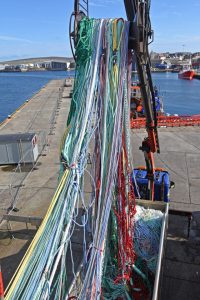
Taking the 1,280m PEPA trawl, made by Swan Net-Gundry…
Swan Net-Gundry is proud to continue its long association with Shetland skipper Bobby Polson and his family by supplying a new PEPA midwater trawl to Serene.
The main features of the 1,280m trawl are the PEPA twine in the top and side panels, that give optimum spread and opening, and Danline on the lower panel, for better abrasion protection when fishing the net hard down on the bottom when mackerel, herring and horse mackerel move onto shady ground.

… aboard Serene at Lerwick …
The trawl’s new eight-panel back-end is a feature that SNG has introduced in recent years, and it has given great readings, especially in the area where the tunnel sensor is placed. The feedback SNG has received from skippers on this model of net is encouraging, as they have obtained readings that are in parity with conventional trawls of a larger fishing circle.
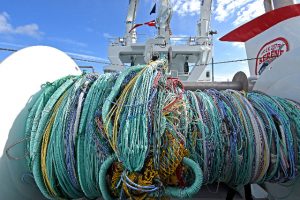
… onto the upper net drum.
Shooting the net off the drum is also easier than with the conventional twine. The colour-coded wings are a great help for crews, letting them identify any impending damage. SNG is now also colour-coding the bottom sections of the starboard and port wings, and this further development has secured highly favourable feedback from crewmen onboard various vessels.
SNG was also delighted to secure the order to supply its Dynice rope products, which it believes are the best-quality Dynice rope in the global market, for the backstraps, pennants and vees, and also the messengers now in use on Serene.
The management and staff at Swan Net-Gundry Ireland and Shetland wish Bobby, Bobby Jr, Brian, David, Gibby, Leonard, Tommy, and the crew of Serene all the best for the future.
Shetland specialist delivers advanced wheelhouse electronics
H Williamson & Sons Ltd of Scalloway, Shetland, designed, supplied, installed and commissioned the state-of-the-art electronic equipment that is now performing well on Serene.

Serene’s all-important forward searching sonars.
The superbly finished wheelhouse includes a number of new ideas. One that is immediately apparent is the two-level layout, in which a recessed central office area surrounded by waist-height glass panels is positioned half a deck lower than the main floor of the wheelhouse. By maximising sightlines in all directions, this arrangement emphasises the space available in the futuristic wheelhouse.
The second obvious innovation is the Furuno (UK)/Böning video wall, in which five 55in 4K Hatteland pedestal-mounted screens are arranged in a shallow arc across the front of the wheelhouse, to give an integrated fishing bridge system. The layout of screen displays on the video wall is controlled by various presets. By using one of three 24in touchscreen controllers, skipper Bobby Polson can select his preference from these when Serene is searching for marks, towing, steaming, or entering/leaving port.

The fully-integrated Furuno video wall, installed by H Williamson & Sons is arranged…
The touchscreen panels also have radar and sonar control functionality. So, for example, common functions to sonar operation, eg gain/range/tilt for each sonar, can now be operated from one panel. The sonar and radar control units are hidden in the console, and can be pulled out if required.
The video wall is located in front of two Recaro Northsea skipper’s chairs supplied by Crown Marine, positioned between wing and island consoles, which together form the main navigation position.
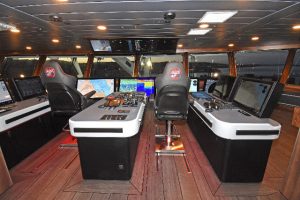
… across the front of the main fishing and steaming position.
Slim wing consoles, which come into play when Serene is manoeuvring in confined areas, are located at the forward corners of the wheelhouse.
The central fishing console aft provides a commanding view of midwater trawling activities across the stern. A further 16 26in Hatteland screens are fitted on the various consoles.
A relaxing day area is arranged to port, forward of a glass-enclosed office.
The advanced level of electronic equipment featured on Serene is further underlined by the presence of dual Furuno Telchart electronic chart display and information systems (TECDIS) utilising T-2138B dual BB processing units.
Providing fast, intuitive course planning and navigation monitoring, the dual TECDIS units are supported by Furuno solid state Doppler DRS6NXT, FAR3210-BB and FAR3230SSD-BB radars.
For long-range fish detection, Serene is equipped with the latest-model low-frequency omni-sonar from Furuno. The FSV-25 has a narrow vertical beam, allowing echo detection at very long range.
For medium- and close-range echo detection, skipper Bobby Polson uses a Furuno FSV-85 medium-frequency (71/84kHz) sonar, providing excellent clarity on smaller marks coming off the bottom.
Vertical echo detection is performed by three Furuno sounders.
Furuno’s FCV-1900G CHIRP echosounder, centred on 50kHz and 200kHz frequencies, is installed with Airmar’s new CHIRP transducer technology for optimal echo detection.
Furuno’s FSS-1BB discrimination echosounder is also installed, to help ensure that only the target species actually ends up in the net. Sweeping through a broad range of frequencies, the sounder calculates the breakdown of species types in any given shoal, and provides graphical information to the skipper.
The third vertical sounder is a Furuno FCV-2100 split-beam unit.

Three 24in touch-screen controllers have various presets, enabling the operator to quickly select preferred displays in relation to Serene’s prevailing mode of operation.
An 80kHz WASSP multi-beam sounder is also fitted, to provide a real-time 120º port-starboard view of the seafloor and water column.
Net-monitoring technology is provided by Simrad trawl sonars and Marport sensors. Serene is equipped with a Simrad FS-70 Sim-Sounder trawl sonar, operating through the cable winch on the aft gantry. The Sim-Sounder option allows a much faster down sounder update, giving real-time observation of the footrope. Up to six catch sensors can be used with this system.
The Marport net-sensor system receives net data through six hydrophones simultaneously, giving excellent reception of all sensor data from the net and doors. The supplied catch sensors can transmit to both the trawl sonar and hull hydrophones, ensuring catch sensor data is always available to the skipper.
Serene is also equipped with three Marport trawl explorer sensors, giving a proper echosounder-type display from the net tunnel or headrope. An additional catch-sounder sensor is mounted in the codend. This is a new sensor from Marport, giving another echosounder-type display of fish movements further into the codend.
The Marport door sensors, with depth, pitch and roll functions, are proving to be a very valuable tool, allowing excellent monitoring of the doors’ attitude and height. This has especially improved fishing efficiency at night, as door depth can be constantly monitored and adjusted. All this information is displayed on Marport’s Scala software, powered by Apple, giving a very flexible and fast system.
The Marport trawl-monitoring system is integrated into the MaxSea TimeZero plotting system, to enable the position of the doors to be shown relative to the vessel.
Navigation equipment supplied by H Williamson & Sons includes MaxSea and Sodena plotters. GPS and heading data is provided by 2 x Furuno GP-170 GPS receivers, Furuno SC-70 satellite, 2 x Simrad GC80 gyro compasses, and a Navitron NT999 dual-head autopilot.
AIS information is handled by the latest-model Furuno FA-170, and a Furuno C168 Doppler indicator provides tidal current data at five different depths, passing this information to the long-range sonars.
Due to the size of Serene, a voyage data recorder (VDR) was a mandatory installation. Similar to an aeroplane’s black box, the Furuno VR-7000 VDR collects all relevant data from the engine, steering, thrusters, alarms, radars, ECDIS, GPS, AIS, etc, and records it for up to four weeks.
A Furuno BR-500 watch alarm system gives peace of mind to the skipper and crew when Serene is steaming to and from the fishing grounds.
A full Sailor GMDSS package was also installed by H Williamson & Sons, including 6320 MH/HF RTs, RT6222 Class A VHFs, Entel HT649 handheld VHFs, Furuno Felcom 18 Sat C, and Furuno NX700B Navtex. Jotron EPIRBs and SARTs are also fitted.
Satellite TV is provided by a Sea Tel 120 1.2m TVRO package.
Whalsay lives on fishing
The large number of family and friends who gathered on the piers to watch Serene go alongside in Symbister harbour for the first time, before going aboard the vessel, is indicative of the vitally important socio-economic contribution fishing makes on the small island of Whalsay.
If any confirmation of this was needed, it was readily available on boarding the local ferry at Laxo, when potential future fishermen returning home from playing football on the mainland, and excitedly discussing Serene’s arrival a few hours later, were proudly wearing their Whalsay team tops, sponsored by the Serene and Charisma fishing companies.

Serene berthed in Symbister harbour on Whalsay, where fishing is the lifeblood of the small island community.
Lying a few miles to the east of mainland Shetland, Whalsay, which is less than six miles long and two miles wide, and has a resident population of just over 1,000, probably has the largest concentration of vessel owners and fishermen in Britain.
When Serene left Symbister for Lerwick two days later, she passed the new seine boat Tranquility LK 63, which started fishing in June.
Next month, Research LK 62, the first of four new midwater trawlers scheduled to be handed over to Whalsay fishing companies in the next nine months, will arrive in Shetland. Adenia LK 193, Charisma LK 362 and Zephyr LK 394 will follow in the summer of 2019, less than three years after another new midwater trawler, Antares LK 419, and the fly-shooter Resilient LK 195, joined the Whalsay fleet.
This level of continuing reinvestment in an industry that is the lifeblood of the community is a fantastic achievement. It is also a ringing endorsement of the long-term confidence in the health of the demersal and pelagic stocks, which is self-evident on the rich fishing grounds around Shetland, and underlines the crucial importance of a successful outcome to Brexit.
SERENE LK 297
DETAILS
Owners: Serene Fishing Company Ltd, Whalsay, Shetland
Designer/boatyard: Karstensens Shipyard, Skagen, Denmark (hull built by Nauta Shipyard, Gdansk, Poland)
Class: DNV-GL + 1A1 Fishing Vessel TMon, Hull: Ice-C
Agent: LHD Ltd, Lerwick, Shetland
DIMENSIONS and CAPACITIES
Length overall: 82m; Length between pp: 72m;
Beam: 17.2m; Depth first deck: 12.35m; Depth second deck: 9.50m; Depth third deck: 6.50m; Draft: 8.6m; Tonnage: 4,141GT; Fuel: 547,000 litres;
Freshwater: 73,000 litres; RSW: 11 tanks – 2,900m³
ENGINEROOM
Main engine: MAN 12V32/44CR-TI of 7,200kW @ 750rpm driving through a Scana Volda ACG-980/PS750 two-speed (5.316/6.5:1 reduction gearbox) to a Scana Volda CP95/4 4,500mm-diameter four-bladed CP propeller in a fixed nozzle; Speed: 17.2 knots
Shaft generator: AEM SF 710 S6 3,500kW (4,375kVA) @ 1,200rpm 415/3/50 with sliding (50/60Hz) frequency
Auxiliary engines: 2 x MAN 6L21/31 of 1,290kW @ 900rpm driving 1,254kWe Stamford 415/3/50 generators; 1 x Cummins QSM11-DM 250kWe harbour/emergency genset; 1 x Cummins QSB7-DM 125kWe genset
Sidethrusters: 2 x Brunvoll FU-74-LTC2000 of 1,400kW
Fuel/lube oil separators: GEA Westfalia; Main engine and hydraulic cooling, bilge/ deckwash/fire ballast and engine fuel transfer pumps: Bombas Azcue; Bilge ejectors: Ellehammer; Starting/working air compressors: Atlas Copco LT 20-30 and FA 11FF
DECK MACHINERY
Suppliers: Karmøy Winch AS, Kopervik, Norway; SeaQuest Ltd, Killybegs, Co Donegal
Karmøy Winch AS: 2 x split trawl winches, 90t first layer pull with capacity for 2,700m 38mm-diameter trawl wire; Karm computer autotrawl system; 2 x net drums 111t; 1 x topline winch 83t; 1 x tail-end winch 57t; 6 x mooring winches 11.1t; 2 x anchor windlasses 14.7t; 1 x netsounder cable winch; 1 x fish hose reel; 1 x hydraulic hose reel; 2 x 3.5t/14m knuckle-arm trawl gantry cranes; 1 x 3.1t/18m knuckle-arm foredeck crane
SeaQuest Ltd: 2 x 24in SeaQuest fish pumps
FISH PUMPING/STORAGE
Fish pumping system: 2 x 24in SeaQuest fish pumps; RSW cooling plant: Johnson Controls (York/Sabroe), 2 x 1,450kW (1,233,000kCal/hr); Vacuum landing system: 2 x Iras c/w 2 x 4,200-litre tanks served by 4 x 66kW compressors; Vessel monitoring system: Marine Control Services
ELECTRONICS
Supplier: H Williamson & Sons Ltd, Scalloway
Fish detection
Furuno FSV-25 360° low-frequency (18/20/22kHz) and Furuno FSV-85 360° medium-frequency (71/84kHz) sonars; Furuno FSV1900B dual-frequency (50kHz/200kHz) CHIRP, Furuno FSS-BB1MK2 fish ID and Furuno FCV-2100 split-beam sounders; WASSP WMBT-80F multi-beam sonar; Furuno C168 Doppler current indicator (160kHz); Simrad FS-70 trawl sonars c/w Sim-Sounder option and four Simrad catch sensors; 1 x Marport M6 acoustic receiver c/w 6 x wide-band hydrophones, 3 x trawl explorers for tunnel, 4 x catch sensors and 2 x door sensors with pitch, roll and depth, 1 x catch eye sensor and 3 x chargers
Navigation
Furuno DRS6NXT, FAR3210-BB and FAR3230SSD-BB radars; dual Furuno TECDIS systems c/w T-2138B dual BB processing units; 2 x Furuno GP170 GPS receivers; Sodena and MaxSea TimeZero plotting systems; Navitron NT999 dual-head autopilot interfaced to 2 x Simrad GC80 gyrocompasses and Furuno SC-70 satellite compass; Furuno FA170 AIS; Furuno BR500 bridge watch alarm; Furuno VR7000 voyage data recorder; Gill Windsonic anemometer
Communications
Sailor 6310 MF/HF 150W GMDSS RT; Sailor 6222 GMDSS VHF; 3 x Entel HT649 handheld GMDSS VHFs; 3 x Sailor 6248 VHFs; Icom F5062 VHF; Icom F6062 UHF; Sailor 6042 bridge wing control unit; Furuno Felcom 18 Sat C; Furuno NX700B Navtex; Jotron 60S GPS EPIRB; 3 x Sailor SP3520 GMDSS handheld VHFs; 2 x Furuno LH-3000 intercoms; Tron 60 GPS EPIRB; 2 x Tron SART 20; 2 x Furuno Turbosailor VSATs; Wheelhouse GSM phone and DECT handset; Pei Tel GSM ECR phone; Deck comms – 16 x Icom F1000 PMR VHFs and 10 x Geko headsets; Sea Tel 120 TVRO satellite TV system; CCTV camera system c/w 16 cameras
FISHING GEAR
Midwater trawl gear: Swan Net-Gundry, Killybegs – 1 x 1,280m PEPA midwater net; Selstad AS, Måløy – 1 x 1,100m single-boat midwater trawl; KT Nets, Killybegs – 2 x 80m heavy-duty eight-panel braillers;
Trawl wire: Oliveira, Portugal – 2 x 2,000m of 38mm diameter;
Midwater trawl doors: Thyborøn Type 15 VF 1,400kg
ACCOMMODATION
14 x single-berth en suite cabins plus hospital cabin
GENERAL
Engine controls: Scana Volda Neptune II CPP; Insurance: British Marine; Lifesaving appliances: Viking and Ikaros; Paint: Sigma; Skipper’s chairs: Crown Marine – 3 x Recaro Northsea; Steering: Rolls-Royce Tenfjord SR 722 – 270kNm; Windows: Van Winderden; Wipers: Wynn Straight-Line



